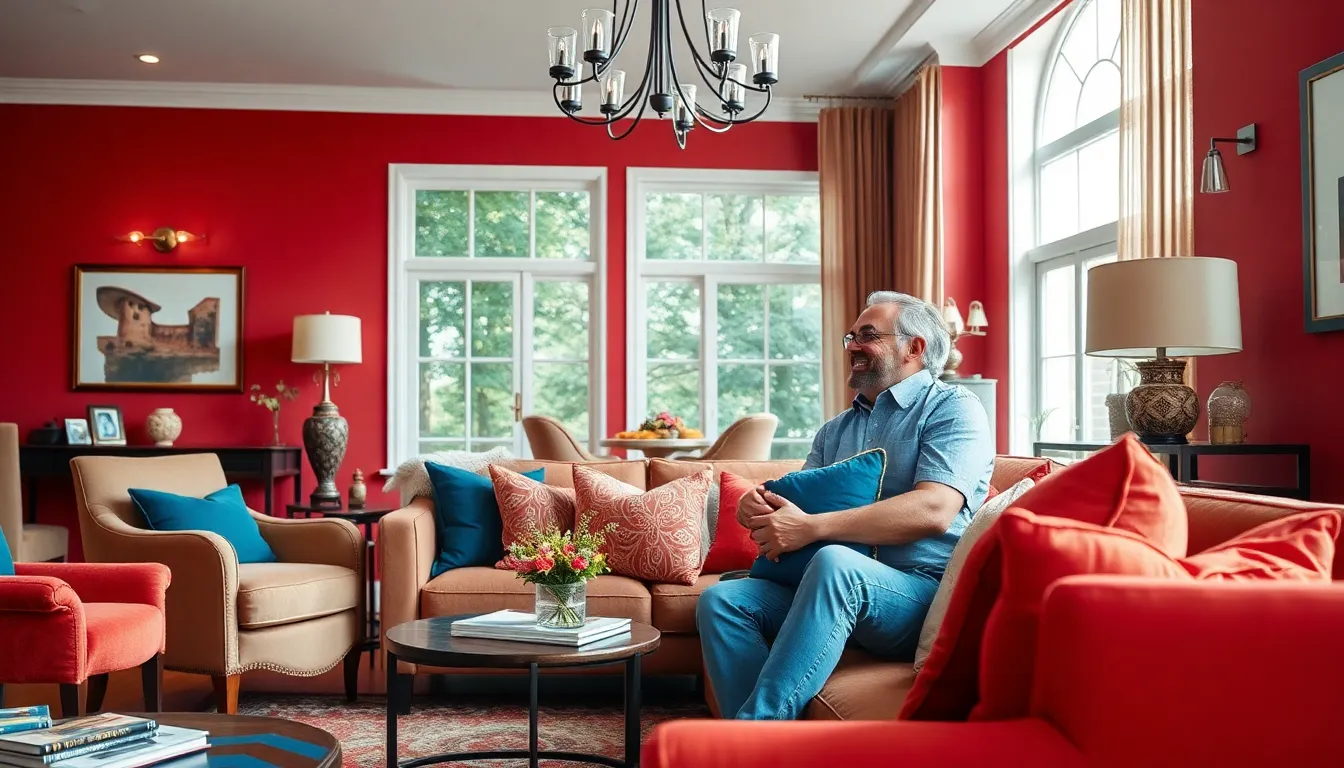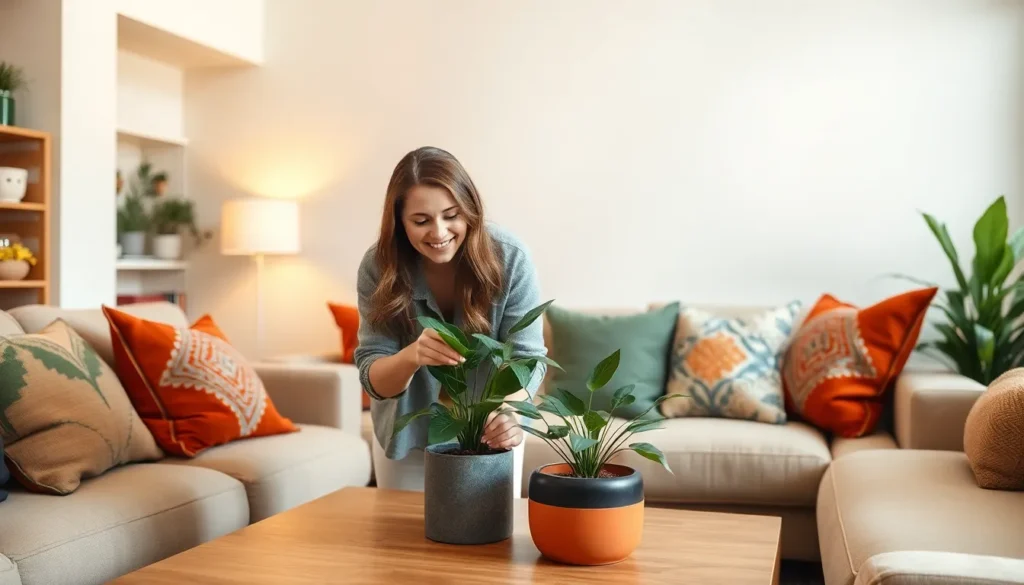Transforming a house into a home isn’t just about sticking a few family photos on the walls and calling it a day. It’s an art form that blends creativity, functionality, and a sprinkle of personality. Whether it’s a cozy nook for curling up with a good book or a vibrant space that sparks joy, home decor interior design plays a crucial role in shaping the atmosphere of any living space.
Table of Contents
ToggleOverview of Home Decor Interior Design
Home decor interior design involves the art of creating functional and aesthetic spaces. It incorporates color schemes, furniture selection, lighting, textures, and accessories that resonate with individual preferences. Creativity plays a crucial role in this process, allowing designers to tailor environments to reflect personal styles.
Functionality remains key in interior design. Space planning measures ensure that areas maximize usability and comfort. For instance, open layouts enable social interaction, while cozy corners provide relaxing retreats.
Color selection influences mood and perception. Warm tones, like yellows and oranges, promote positivity, while cooler shades, such as blues and greens, encourage tranquility. Choosing complementary colors enhances room coherence and harmony.
Furniture selection also contributes to overall design. Stylish couches, elegant tables, and practical storage solutions balance beauty and utility. Designers often select multifunctional pieces to optimize space without sacrificing aesthetics.
Lighting serves as another vital element in home decor. Natural light adds warmth and openness, while strategically placed lamps and fixtures create ambiance. Selecting the right style of lighting enhances both functionality and design.
Accessories, including artwork, textiles, and plants, offer personal touches. They complete a design by adding layers of texture and interest. Thoughtful placement of these elements elevates overall decor appeal.
Understanding and implementing these fundamental aspects of home decor interior design leads to inviting and harmonious environments. Balancing creativity and functionality ultimately transforms living spaces into homes that reflect the personalities and lifestyles of their inhabitants.
Key Elements of Home Decor Interior Design

Understanding key elements enhances home decor interior design. Focus on aspects such as color schemes, furniture selection, and lighting design.
Color Schemes
Color schemes significantly impact the overall atmosphere of a space. Warm tones like reds and oranges create energy and promote social interaction. Cool shades, including blues and greens, offer calmness and peace. Neutral colors form a versatile base, allowing for easy incorporation of accents. Choosing the right color palette connects the various elements in the room, ensuring visual harmony. Consider the intended mood while selecting colors to make thoughtful choices that resonate with personal style.
Furniture Selection
Furniture selection plays an integral role in designing functional and aesthetically pleasing spaces. Prioritize comfort while ensuring each piece complements the overall design theme. Mixing styles can create intriguing contrasts, while cohesive designs enhance tranquility. Sizing matters; oversized furniture can overwhelm a small area, while petite pieces may fail to fill larger spaces adequately. Selecting multifunctional furniture maximizes usability, particularly in smaller homes. Aim for quality furnishings that withstand wear and reflect personal taste.
Lighting Design
Lighting design shapes the ambiance and functionality of a room. Layering light sources—ambient, task, and accent—establishes a balanced atmosphere. Natural light enhances moods and reduces reliance on artificial alternatives, making windows and mirrors essential. Choosing fixtures that match the decor style ensures unity throughout the space. Dimmable lights allow for adjustable brightness, accommodating various activities and occasions. Consider each room’s specific needs to create a well-lit, inviting environment.
Popular Styles in Home Decor Interior Design
Home decor interior design encompasses various styles, each offering unique aesthetics and functionality. Understanding these popular styles enables individuals to create spaces that resonate with their preferences.
Modern Minimalism
Modern minimalism emphasizes simplicity and functionality. Clean lines and uncluttered spaces define this style. Neutral color palettes highlight subtle elegance, while careful furniture selection ensures both beauty and utility. Minimalist decor prioritizes essential elements, often using geometric shapes and natural materials. Accessories remain sparse yet meaningful, focusing on a few statement pieces. The absence of excess allows each item to shine, fostering a serene and inviting atmosphere.
Rustic Charm
Rustic charm blends warmth and authenticity. Natural materials like wood, stone, and metal create a cozy environment. Earthy color schemes, including browns, greens, and soft whites, establish a connection to nature. Vintage and handcrafted items add character and personal history to spaces. Soft textiles such as linen and wool enhance comfort and coziness, contributing to a welcoming feel. A layered approach to decor highlights individual pieces that tell a story, inviting familiarity and nostalgia.
Bohemian Vibes
Bohemian vibes celebrate individuality and artistic expression. A mix of colors, patterns, and textures creates a vibrant atmosphere. Layered textiles, such as rugs, throws, and cushions, invite comfort and relaxation. Plants play a significant role in this style, bringing life and freshness to spaces. Eclectic decor combines cultural elements, often featuring handcrafted or vintage items that reflect personal journeys. The overall effect captures an inviting, free-spirited ambiance, encouraging creativity and self-expression.
Tips for Effective Home Decor Interior Design
Effective home decor transforms a house into a personalized sanctuary. The following tips aid in achieving a beautifully designed interior.
Maximizing Space
Utilize multifunctional furniture to save space and enhance usability. Consider storage ottomans or coffee tables with compartments for added functionality. Open floor plans work well, allowing for seamless transitions between spaces. Choosing light color palettes creates an illusion of depth and airiness. Mirrors reflect light and visually expand rooms, making them feel larger. Vertical storage solutions, like tall bookshelves or wall-mounted units, efficiently use wall space. Fewer oversized pieces promote a more spacious feel, so select smaller items that complement the overall design.
Creating a Cohesive Look
Harmonize color schemes throughout the home to establish a consistent aesthetic. Each room should reflect a shared palette, integrating various shades for depth. Use recurring patterns or textures to create connections between different areas. Select a focal point in each room, such as a piece of artwork or a bold piece of furniture, to anchor the design. Vary decorative elements like cushions and rugs while keeping a common theme to enhance cohesion. Integrate lighting styles across spaces, ensuring the ambiance aligns with the overall decor vision. Attention to detail unifies design elements, leading to a harmonious home environment.
Creating a harmonious home involves more than just choosing the right decor. It’s about blending personal style with functionality to craft spaces that truly resonate. By understanding the essential elements of interior design and incorporating various styles, anyone can transform their living environment into a sanctuary.
Thoughtful space planning and strategic use of color and lighting can significantly enhance mood and comfort. Incorporating personal touches through accessories and art not only reflects individuality but also brings warmth to any space. Ultimately, a well-designed home is a reflection of its inhabitants, fostering an atmosphere of joy and relaxation.



